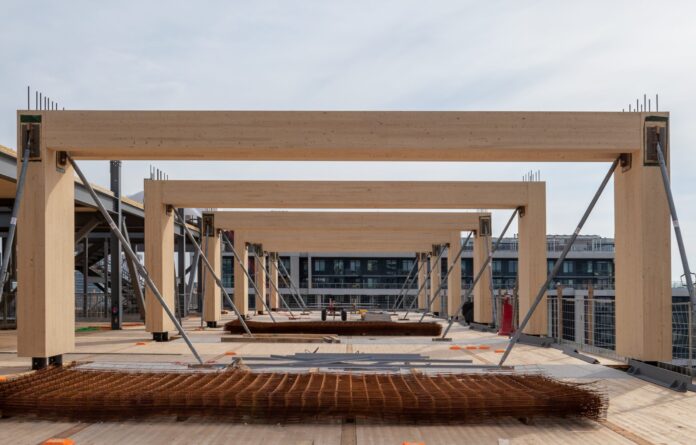Ontario Construction Report editor
Phil Silverstein and Jay Zhao of Moriyama Teshima Architects recently explored the Limberlost Place construction site in Toronto —the first institutional tall wood building in Canada.
PCL and Limberlost Place partners celebrated a significant construction milestone in April, with the installation of a two-story mass timber pedestrian bridge that was erected 65 feet above street level, connecting level five of Limberlost Place to level six of the college’s Daphne Cockwell Centre for Health Sciences.
Watch the tour – https://vimeo.com/850411548
During the walkthrough virtual tour, they share the many stories, innovations and challenges behind this remarkable project: from the design and implementation of its innovative structural system to dealing with moisture during construction and its unique approach to ventilation.
Moriyama Teshima Architects and Acton Ostry Architects designed the project, which has introduced mass timber into the Toronto lexicon of public buildings and to achieve sustainability targets a decade in advance of the city’s step plan to 2030 carbon reductions (Toronto Green Standards Tier 4).
George Brown College’s Limberlost Place, a new addition to the school’s waterfront campus is a tall wood, low-carbon building that will feature ecological innovation across its entire life cycle. The 225,000 square foot, net-zero carbon emissions building also has a “made in Canada” structural solution. Mass wood components have been sourced nationally. As the first institutional tall wood building in Canada, the design provides generous spaces focused on wellbeing and sustainability.
Limberlost Place combines design and structural innovation with advanced prefabricated tall building façade systems, as well as an optimized use of decentralized mechanical systems working in concert with passive systems, to produce a building that is the healthiest environment for both its users and for the planet.
The building, under construction in Toronto, is a mass timber structure, and achieves the highest levels of our municipal targets, well in advance of the 2030 TEDI, TEUI, and GHGI reductions.

